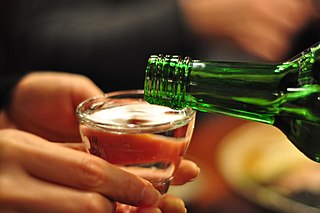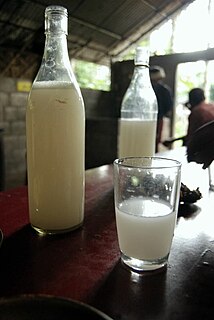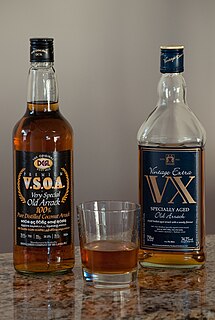
A liqueur is an alcoholic drink composed of spirits and additional flavorings such as sugar, fruits, herbs, and spices. Often served with or after dessert, they are typically heavily sweetened and un-aged beyond a resting period during production, when necessary, for their flavors to mingle.

Soju is a clear and colorless Korean distilled alcoholic beverage. It is usually consumed neat. Its alcohol content varies from about 12.9% to 53% alcohol by volume (ABV), although since 2007 low alcohol soju below 20% has become more popular.

Palm wine, known by several local names, is an alcoholic beverage created from the sap of various species of palm tree such as the palmyra, date palms, and coconut palms. It is known by various names in different regions and is common in various parts of Africa, the Caribbean, South America, South Asia, Southeast Asia and Micronesia.

Shōchū is a Japanese distilled beverage. It is typically distilled from rice, barley, sweet potatoes, buckwheat, or brown sugar, though it is sometimes produced from other ingredients such as chestnut, sesame seeds, potatoes, or even carrots.

Herrera is a province in Panama. Named after General Tomás Herrera, the province was founded on January 18, 1915 from a division of the Los Santos province. The capital city of Herrera is Chitré, which is located near the province's coastline. Herrera is bordered on the north by the provinces of Veraguas and Coclé, on the south by the province of Los Santos, on the east by Golfo de Parita and the province of Los Santos, and on the west by the province of Veraguas.

Aguardiente, in Spanish, or aguardente, in Portuguese is a generic term for alcoholic beverages that contain between 29% and 60% alcohol by volume (ABV). It originates in the Iberian Peninsula, as well as Iberian America.

Baijiu, also known as shaojiu (烧酒/燒酒), is a colorless Chinese liquor typically coming in between 35% and 60% alcohol by volume (ABV). Each type of baijiu uses its own type of qū for fermentation to create a distinct and characteristic flavor profile.

Liquor is an alcoholic drink produced by distillation of grains, fruits, vegetables, or sugar, that have already gone through alcoholic fermentation. Other terms for liquor include: spirit drink, distilled beverage or hard liquor. The distillation process concentrates the liquid to increase its alcohol by volume. As liquors contain significantly more alcohol (ethanol) than other alcoholic drinks, they are considered "harder" – in North America, the term hard liquor is sometimes used to distinguish distilled alcoholic drinks from non-distilled ones, whereas the term spirits is used in the UK. Examples of liquors include brandy, vodka, absinthe, gin, rum, tequila, and whisky.

Armagnac is a distinctive kind of brandy produced in the Armagnac region in Gascony, southwest France. It is distilled from wine usually made from a blend of grapes including Baco 22A, Colombard, Folle blanche and Ugni blanc, traditionally using column stills rather than the pot stills used in the production of cognac, which is made predominantly from ugni blanc grapes. The resulting spirit is then aged in oak barrels before release. Production is overseen by the Institut national de l'origine et de la qualité (INAO) and the Bureau National Interprofessionel de l'Armagnac (BNIA).

Arrack is a distilled alcoholic drink typically produced in India, Sri Lanka and Southeast Asia, made from the fermented sap of coconut flowers or sugarcane, and also with grain or fruit depending upon the country of origin. It is sometimes spelled arak, or simply referred to as 'rack or 'rak. It is not to be confused with the anise-flavored distilled spirit called arak or araq.
An alcohol-free or non-alcoholic drink, also known as a temperance drink, is a version of an alcoholic drink made without alcohol, or with the alcohol removed or reduced to almost zero. These may take the form of a non-alcoholic mixed drink or non-alcoholic beer, and are widely available where alcoholic drinks are sold.

Rum is a liquor made by fermenting and then distilling sugarcane molasses or sugarcane juice. The distillate, a clear liquid, is usually aged in oak barrels. Rum is produced in nearly every sugar-producing region of the world, such as the Philippines, where Tanduay is the largest producer of rum globally.

An alcoholic beverage is a drink that contains ethanol, a type of alcohol that acts as a drug and is produced by fermentation of grains, fruits, or other sources of sugar. The consumption of alcoholic drinks, often referred to as "drinking", plays an important social role in many cultures. Most countries have laws regulating the production, sale, and consumption of alcoholic beverages. Regulations may require the labeling of the percentage alcohol content and the use of a warning label. Some countries ban such activities entirely, but alcoholic drinks are legal in most parts of the world. The global alcoholic drink industry exceeded $1 trillion in 2018.
Moonshine is a generic term for distilled alcoholic beverages made throughout the globe from indigenous ingredients reflecting the customs, tastes, and raw materials for fermentation available in each region. The term commonly applies to small-scale production, which is often illegal or tightly regulated in many countries, in the same order that is for example making food.
Cholai is an illegal alcoholic beverage made in India, equivalent to "hooch" or "bootleg" alcohol. Usually made from rice, it is sometimes mixed with industrial alcohol or methanol, which has resulted in several hundred deaths.

Tubâ is a Filipino alcoholic beverage created from the sap of various species of palm trees. During the Spanish colonial period, tubâ was introduced to Guam, the Marianas, and Mexico via the Manila Galleons. They remain popular in Mexico, especially in the states of Colima, Jalisco, Michoacán, Nayarit, and Guerrero. Tubâ was also introduced to the Torres Strait Islands of Australia in the mid-19th century by Filipino immigrant workers in the pearling industry.












